Apple Inc.
![]()
This article is about the electronics company. For other meanings, see Apple (disambiguation).
Apple Inc. [ˈæpəlˌɪŋk] is a U.S. hardware and software developer and a technology company that develops and distributes computers, smartphones and consumer electronics, as well as operating systems and application software. In addition, Apple operates an internet distribution portal for music, movies, and software. Apple's headquarters, Apple Park, is located in Cupertino, California.
Apple was founded in 1976 by Steve Wozniak, Steve Jobs and Ron Wayne as a garage company and was one of the first manufacturers of personal computers. The company contributed significantly to their development as a mass product. Apple pioneered the introduction of the graphical user interface and the mouse in the 1980s with the Lisa and Macintosh computers. With the release of the iPod (2001), iPhone (2007), and iPad (2010), Apple gradually expanded its business into other product areas. It thus laid the foundation for the boom in the smartphone and tablet computer markets that continues to this day. In recent years, the iPhone has become Apple's most important product, accounting for more than 50% of the group's total revenue.
The iTunes Store for music and movie downloads, which opened in 2003, became the first commercially successful download portal and played a decisive role in shaping this market. Today, the iTunes Store and the App Store, which opened in 2008, are two of the world's largest distribution channels for digital goods.
Company
Name
The name Apple Computer was Steve Jobs' idea, Wozniak did not agree with it at first. Since both could not think of another name within a self-imposed deadline, Jobs registered the company as "Apple Computer". Jobs himself explained:
"We were three months behind in registering our company name at the time, and I threatened to call the company 'Apple Computer' if no one came up with a more interesting name by five o'clock. I hoped it would spark creativity. But the name stuck. And that's why we're called 'Apple' today."
- Steve Jobs
"I was once again practicing one of my fruit diets. I had just returned from the apple orchard. The name sounded friendly, peppy, and not intimidating. Apple took the edge off the term computer. Besides, in the future we'd be in the phone book before Atari."
- Steve Jobs
This second statement is confirmed by Steve Wozniak in his autobiography iWoz.
Litigation
In 1981, the company name first led to conflicts with the Beatles label "Apple Records". Apple avoided a lawsuit over the name by pledging not to get involved in the music industry. As Apple computers became more advanced with multimedia capabilities in the years that followed, litigation finally ensued in 1989, ending with an out-of-court settlement. Apple's sales of the iPod and operation of the iTunes Store again led to litigation, which was settled in February 2007. Apple has since owned all trademark rights to the "Apple" name and licensed certain rights to the music label. Financial details were not disclosed.
In September 2011, Apple objected to the establishment of a trademark application on the part of the Bonn café apfelkind. The café wanted to secure a logo with the pattern of a head inside an apple. Apple objected to the registration of the logo at the German Patent and Trademark Office in Munich on the grounds of a "high degree of likelihood of confusion". The owner rejected a compromise proposal by Apple to limit logo use to the café - and in particular not to use the logo for covers for digital devices, computer or video games - and responded with a counterclaim, which Apple did not address. On 17 September 2013, Apple withdrew the opposition at the Patent Office without giving reasons after a settlement with the café failed.
Apple logo
The first logo was a drawing in the style of a baroque copperplate engraving showing Isaac Newton sitting under an apple tree - a reference to the discovery of gravity with the help of an apple. This design came from Ron Wayne. However, it was quickly discovered that this logo was difficult to reproduce because it was far too small, and so it was discarded.
· 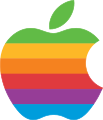
Multicoloured Apple logo
· ![]()
Apple II logo
· ![]()
Apple lettering with logo from the 1990s
· 
Black Apple logo, in use since 1998
The bitten apple silhouette striped in rainbow colors was designed by Rob Janoff in 1977. Allusions to Isaac Newton or Alan Turing, who is considered one of the fathers of the computer and who apparently died of a poisoned apple, are often seen in it, as well as a pun on the English word bite, which sounds exactly like byte, but which Janoff himself denies. While the Apple II could display colors, a monochrome version of the logo was often used for other purposes at first.
For the text part of the logo, the typeface Motter Tektura by Othmar Motter was used, published by Letraset Ltd. in Great Britain. For the first Macintosh models, only the colored apple was used as a picture logo. From operating system version 7 onwards, the logo was displayed in the form of a word mark in Bitstream Garamond, which better reflected the new TrueType capability.
Since 1998, the logo has mostly been displayed in one colour only, but in changing colours and sometimes with surface textures, depending on the surrounding design. The appearance of the logos on today's products is mostly colourless. They only stand out from the background due to their surface structure. In the context of an environmental protection campaign, at times, for example on Earth Day, the leaf of the logo is partially dyed green, the representation of the Apple Stores is also adapted in these cases. There was an urban legend that the design of the logo was inspired by British mathematician Alan Turing, who took his own life by biting into a poisonous apple. Steve Jobs denied this after questioning by Stephen Fry.
Employees
Between 1997 and 2011, Jobs was CEO of Apple. After his resignation on August 24, 2011, Tim Cook, who was previously COO in charge of operations, took over the post. Other high-ranking managers include Eddy Cue (online services), Craig Federighi (software), John Giannandrea (machine learning), Phil Schiller (marketing) and Johny Srouji (chip design).
Arthur D. Levinson (former Chairman and CEO of Genentech) has been Chairman of the Board of Directors since November 2011. Other members are James Bell (former President and CFO of Boeing), Apple CEO Tim Cook, Al Gore (former Vice President of the United States), Robert Iger (CEO of Disney) and Andrea Jung (former Chairwoman and CEO of Avon Products). Eric Schmidt (former CEO of Google) left the Board of Directors on August 3, 2009, as conflicts of interest were feared in view of the increasing competition between Google and Apple.
Important Apple employees in connection with the development of Lisa and Macintosh were Jef Raskin (usability specialist), Andy Hertzfeld, Bill Atkinson and Susan Kare, who designed among other things numerous icons for the Macintosh system.
The company employed around 123,000 people (counted in full-time equivalents) in September 2016. About half of the employees work in the retail sector. The internal education program for employees is called Apple University.
Apple Stores
The Apple Stores embody an unusual concept that places great emphasis on visitor interaction with the products. To implement this, almost all products on display can be tried out by customers; shelves and similar typical elements of other retail stores are not present. This concept is considered a major reason for the success of Apple's retail stores. Each store contains a Genius Bar where customers are helped with Apple products.
The company operates over 500 Apple retail stores worldwide. More than half of these are located in the USA, with additional stores in around 20 other countries. In Germany there are a total of 15 stores: two each in Munich (Innenstadt and OEZ), Hamburg (Jungfernstieg and Alstertal-Einkaufszentrum) and Cologne (Rhein-Center and Schildergasse), as well as one each in Frankfurt am Main (Freßgass), in Oberhausen (CentrO), in Dresden (Altmarkt-Galerie), in Augsburg (City-Galerie), in Sulzbach (Main-Taunus-Zentrum), in Sindelfingen, in Berlin (Kurfürstendamm), in Düsseldorf (Kö-Bogen) and in Hanover (Bahnhofstraße). In Switzerland, there are four Apple Retail Stores; two in Zurich (Rennweg and Glattzentrum), one in Geneva and one in Basel. In Vienna (Kärntner Straße), Austria's first Apple Retail Store opened on 24 February 2018.
Introduced in 2004, the "Mini" Retail Stores were designed by the Eight Inc. design studio. By 2013, all Mini Retail Stores had been replaced by regular-sized stores.
Financial data
The company is one of the largest companies in the world in terms of various business metrics. In terms of market capitalization, Apple has been the most valuable company in the world since September 2011, with brief interruptions, according to the Financial Times Global 500 list. According to the Fortune Global 500 list, Apple was the 12th largest company in the world by revenue in 2020. In terms of profit, Apple was simultaneously the 3rd most valuable company listed in the Forbes Global 2000. On the lists of the most valuable brands compiled by the market research institutes Millward Brown and Interbrand, the Apple brand has been ranked number 1 or 2 for several years.
Apple's initial public offering took place on December 12, 1980. The share is traded under the abbreviation "AAPL" on the New York Stock Exchange NASDAQ and is a component of the stock indices NASDAQ-100, S&P 500 and Dow Jones.
The company has refrained from paying dividends since 1995, which was increasingly criticized by some shareholders around 2010 in view of high cash reserves. After the group's financial reserves had risen to around 100 billion US dollars, Apple announced in March 2012 that it would pay a dividend of initially 0.38 US dollars per quarter from July of that year. At the same time, Apple announced that it would buy back $10 billion worth of its own shares. By April 2016, Apple increased the share buyback program in several steps to eventually total $175 billion by March 2018, while also raising the dividend to eventually $0.57 per quarter.
| Period(GJ) | Turnover (USD million) | Profit (USD million) | Sales growth | Return on sales |
| FY 1981 (Oct. 80 - Sep. 81) | 335 | unknown. | - — | - — |
| FY 1982 (Oct. 81 - Sep. 82) | 583 | 61 | 74 % | 10 % |
| FY 1983 (Oct 82 - Sep 83) | 983 | 77 | 69 % | 8 % |
| FY 1984 (Oct 83 - Sep 84) | 1.516 | 64 | 54 % | 4 % |
| FY 1985 (Oct. 84 - Sep. 85) | 1.918 | 61 | 27 % | 3 % |
| FY 1986 (Oct 85 - Sep 86) | 1.902 | 154 | −1 % | 8 % |
| FY 1987 (Oct 86 - Sep 87) | 2.661 | 218 | 40 % | 8 % |
| FY 1988 (Oct 87 - Sep 88) | 4.071 | 400 | 53 % | 10 % |
| FY 1989 (Oct 88 - Sep 89) | 5.284 | 454 | 30 % | 9 % |
| FY 1990 (Oct 89 - Sep 90) | 5.558 | 475 | 5 % | 9 % |
| FY 1991 (Oct. 90 - Sep. 91) | 7.977 | 310 | 44 % | 4 % |
| FY 1992 (Oct. 91 - Sep. 92) | 7.087 | 530 | −11 % | 7 % |
| FY 1993 (Oct. 92 - Sep. 93) | 6.309 | 87 | −11 % | 1 % |
| FY 1994 (Oct. 93 - Sep. 94) | 9.189 | 310 | 46 % | 3 % |
| FY 1995 (Oct. 94 - Sep. 95) | 11.602 | 424 | 20 % | 4 % |
| FY 1996 (Oct. 95 - Sep. 96) | 9.833 | −816 | −11 % | −8 % |
| FY 1997 (Oct. 96 - Sep. 97) | 7.081 | −1.045 | −28 % | −15 % |
| FY 1998 (Oct. 97 - Sep. 98) | 5.941 | 309 | −16 % | 5 % |
| FY 1999 (Oct. 98 - Sep. 99) | 6.134 | 601 | 3 % | 10 % |
| FY 2000 (Oct. 99 - Sep. 00) | 7.983 | 786 | 30 % | 10 % |
| FY 2001 (Oct. 00 - Sep. 01) | 5.363 | −25 | −33 % | −0 % |
| FY 2002 (Oct 01 - Sep 02) | 5.247 | 65 | −2 % | 1 % |
| FY 2003 (Oct 02 - Sep 03) | 6.207 | 57 | 18 % | 1 % |
| FY 2004 (Oct 03 - Sep 04) | 8.279 | 266 | 33 % | 3 % |
| FY 2005 (Oct 04 - Sep 05) | 13.931 | 1.328 | 68 % | 10 % |
| FY 2006 (Oct 05 - Sep 06) | 19.315 | 1.989 | 39 % | 10 % |
| FY 2007 (Oct 06 - Sep 07) | 24.578 | 3.495 | 27 % | 14 % |
| FY 2008 (Oct 07 - Sep 08) | 37.491 | 6.119 | 53 % | 16 % |
| FY 2009 (Oct 08 - Sep 09) | 42.905 | 8.235 | 14 % | 19 % |
| FY 2010 (Oct 09 - Sep 10) | 65.225 | 14.013 | 52 % | 21 % |
| FY 2011 (Oct. 10 - Sep. 11) | 108.249 | 25.922 | 66 % | 24 % |
| FY 2012 (Oct. 11 - Sep. 12) | 156.508 | 41.733 | 45 % | 27 % |
| FY 2013 (Oct. 12 - Sep. 13) | 170.910 | 37.037 | 9 % | 22 % |
| FY 2014 (Oct. 13 - Sep. 14) | 182.795 | 39.510 | 7 % | 22 % |
| FY 2015 (Oct. 14 - Sep. 15) | 233.715 | 53.394 | 28 % | 23 % |
| FY 2016 (Oct. 15 - Sep. 16) | 215.639 | 45.687 | −8 % | 21 % |
| FY 2017 (Oct. 16 - Sep. 17) | 229.234 | 48.351 | 6 % | 21 % |
| FY 2018 (Oct. 17 - Sep. 18) | 265.595 | 59.531 | 16 % | 22 % |
| FY 2019 (Oct. 18 - Sep. 19) | 260.174 | 55.256 | −2 % | 21 % |
| FY 2020 (Oct. 19 - Sep. 20) | 274.515 | 57.411 | 6 % | 21 % |
(FY) Apple fiscal years begin on October 1 of the previous year. Example: Q1/2016Apple corresponds to Q4/2015Calendar.

Visitors to an Apple Store in Paris try out products.
.webm.jpg)
Play media file Apple Double-Sided Floppy Disks with Rainbow Logo
Products
Apple designs both software and hardware, and has most of the latter manufactured by contract manufacturers in and out of Taiwan, including Foxconn, Quanta, and Pegatron.
The products are often considered innovative and usually have a functional design. The clear and straightforward lines are inspired by products of the German electrical appliance manufacturer Braun, which were designed by chief designer Dieter Rams and his team.
Software
→ Main article: List of Apple software
Operating systems
Apple's first operating systems were the Apple DOS, SOS and ProDOS systems used in the Apple II and Apple III series. These were command-line oriented, as was common at the time (late 1970s and early 1980s). In 1983, Apple introduced the Lisa OS, one of the first commercially available operating systems that was operated entirely from a graphical user interface. In 1984, the Macintosh, the first graphical operating system, was released and sold widely. Two years later, the Apple IIgs was introduced, whose GS/OS operating system adopted many of the features of the Macintosh operating system.
With the discontinuation of the Apple II product line in the early 1990s, Apple focused on the Macintosh series, whose operating system was simply called "System" until version 7 and later "Mac OS". Mac OS 9 appeared in 1999, and its successor, Mac OS X, adopted parts of the interface but was based on a completely different operating system core. Mac OS X was renamed OS X with version 10.8, and macOS with version 10.12 in 2016. A server variant, macOS Server (formerly: OS X Server or Mac OS X Server), is available, but as of version 10.7 is no longer distributed as a standalone operating system distribution, but can be installed later via the App Store.
The iPhone uses the iOS operating system and the iPad the iPadOS system, which share the operating system core with macOS, but have a user interface adapted for touchscreens. The operating systems for the Apple TV (tvOS) and the Apple Watch (watchOS) are also technically closely related to iOS and macOS, but each has its own interface.
Applications
Apple's macOS and iOS operating systems include applications for many common fields of application, such as the Safari web browser, the photo management and editing program Fotos, the instant messenger Messages (referred to as Nachrichten in the German-language operating system) or Mail, Contacts and Calendar. In addition, the video editing program iMovie, the music program GarageBand, the word processing program Pages, the presentation program Keynote and the spreadsheet program Numbers can be downloaded for free on every newly purchased Mac or iOS device.
The company also develops software for professional audio and video editing with Logic Pro (audio and sequencing) and Final Cut Pro (video editing). The development of Aperture (photo editing and management) was discontinued in April 2015.
open source
The company publishes the source code of Darwin, the common foundation of macOS and iOS, under the APSL. In addition, macOS and iOS, as well as the developer tools, use various open source projects that Apple participates in developing. These include the WebKit browser engine, which is a leader in the mobile space, the Swift programming language, the LLVM compiler back-end infrastructure, and Clang (C/C++/Objective-C front-end) in particular, as well as parts of Grand Central Dispatch, a library designed to make it easier for software developers to better distribute processor load across processor cores.
Computer
→ Main articles: Apple I-/-II-/-III models and Macintosh models
Desktops
The company currently makes three different desktop computers. The iMac, which combines a computer and display in one chassis, and the cheaper Macmini are aimed at regular users, while the Mac Pro (like the iMac Pro once was) is aimed at compute-intensive tasks like professional video editing. The Mac Pro, unlike the iMac, describes only the computer without a monitor.
· 
Apple II (1977)
· 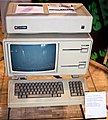
Apple Lisa (1983)
· 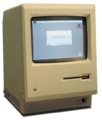
Macintosh (1984)
· 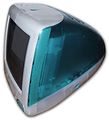
iMac G3 (1998)
· 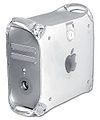
Power Mac G4 Quicksilver (2002)
· 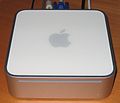
Mac mini (2005)
· 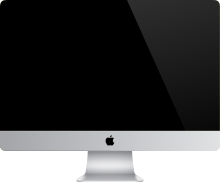
iMac (2013)
Notebooks
Apple's first portable computer was the Macintosh Portable in 1989, which weighed more than 7 kg. Two years later, the company introduced the PowerBook, the notebook design with a recessed keyboard and palm rest that is still common today. Currently, Apple makes two different notebooks: the MacBook Air and the MacBook Pro.
· 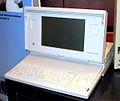
Macintosh Portable (1989)
· 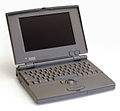
PowerBook 100 (1991)
· 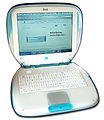
iBook (1999)
· 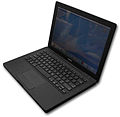
MacBook (2006)
· 
MacBook Air (2008)
· 
MacBook Pro unibody design (2009)
· 
Mac Book Air Retina (2019)
Mobile devices
iPod
→ Main article: iPod
On October 23, 2001, the company introduced the iPod, adding several models over the years. It established itself as the market leader among MP3 players. By September 2012, more than 350 million units had been sold. Today, Apple offers only one iPod model, the iPod touch (iOS-based). The iPod classic was discontinued in September 2014, and the iPod shuffle and iPod nano variants were removed from the market in 2017.
· 
The first iPod (2001)
· 
The iPod family (from left to right: iPod shuffle, nano, classic and touch)
· 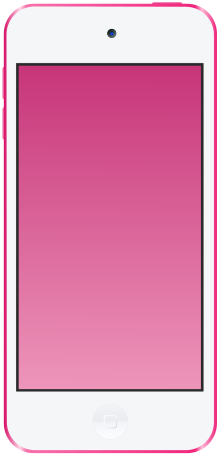
A pink 6th generation iPod touch.
iOS devices
→ Main article: iPhone and iPad
On January 9, 2007, the company introduced the iPhone, followed in the fall of that year by the first iPod with a touchscreen, the iPod touch. Both use the same operating system, which was initially called iPhone OS and renamed iOS in summer 2010 with version 4.0.
In early 2010, the company introduced the iPad, a tablet that also ran iOS. In October 2012, the iPad mini was also introduced, which has a smaller screen than the regular iPad. On September 9, 2015, the iPad Pro was introduced, which has a 70% larger screen.
The Apple TV, introduced in September 2006, initially ran a modified version of Mac OS X; since the hardware was retreaded in September 2010, the Apple TV has run an iOS variant with a customized user interface. From the 4th generation of the Apple TV introduced in 2015, the operating system is called tvOS and has an App Store.
In November 2017, Apple released the iPhone X, which was the first model without a home button. It was followed a year later by iPhone XS, iPhone XS Max and iPhone XR. On September 10, 2019, the iPhone 11, iPhone 11 Pro, and iPhone 11 Pro Max were unveiled. On April 24, 2020, Apple started selling the iPhone SE (2nd gen). On October 13, 2020, iPhone 12, iPhone 12 Mini, iPhone 12 Pro, and iPhone 12 Pro Max were unveiled.
In terms of the number of devices sold, Apple was the third-largest mobile phone brand at mid-year 2018 and the fourth-largest mobile phone manufacturer as a manufacturer (after Samsung, Huawei with the Huawei and Honor brands, and BBK Electronics with the Oppo, Vivo and OnePlus brands).
· 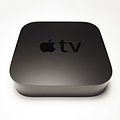
Apple TV (2011/2012)
· 
iPad mini (2012)
· 
iPad Air 2 (2014)
· 
iPhone 6s (2015)
· 
iPhone X (2017)
· 
iPhone XR (Blue, 2018)
Apple Watch
→ Main article: Apple Watch
The Apple Watch is a smartwatch that was announced on September 9, 2014 and has been available since April 24, 2015. The latest Series 6 was introduced on September 15, 2020.
Online services
- App Store - Platform for offering and downloading applications for the iOS, iPadOS and macOS operating systems.
- iTunes Store - iTunes-integrated online platform for purchasing music, movies, and other multimedia content.
- iCloud - partially free cloud computing service that lets you sync mail, appointments, contacts, and photos, for example, between all of your own devices (iPod, iPhone, Mac, and Windows computers)
- Apple Music - Music streaming service launched in 100 countries with iOS 8.4 on June 30, 2015.
- Apple Arcade - Video Games Subscription Service.
- Apple TV+ - Video on Demand Service.
- Apple Fitness+ - Fitness service that offers and records workout videos using Apple devices.
Peripherals and consumer electronics
The company produces various peripherals, including displays (Apple Pro Display XDR, formerly Apple Thunderbolt Display and Apple Cinema Displays), headphones (AirPods) and smart speakers (HomePod), input devices such as mice, keyboards (including Wireless Keyboard) and the so-called Magic Trackpad. Apple also developed the FireWire interface for connecting devices such as video cameras or hard drives, which later became an industry standard under the name "IEEE 1394". Today, this interface is increasingly replaced by Thunderbolt, so that the FireWire interface is no longer present in the products of the new generations.
Earlier, the company offered other peripherals such as WLAN devices (AirPort and Time Capsule), printers (including StyleWriter and LaserWriter) and scanners, digital cameras (including QuickTake and iSight), the iPod Hi-Fi or a docking station and several adapters. Stand-alone devices such as the PDA Newton, the game console Apple Pippin or the CD player PowerCD were also sold. Many of these devices were not in-house developments, but were produced by other manufacturers on Apple's behalf.
Accessibility
The company equips its products with the VoiceOver screen reader, which enables blind and visually impaired users to start up and use the devices independently without assistance after purchase. Furthermore, a so-called Braille display can be connected under both macOS and iOS, which displays the screen content in braille.
In addition to the spoken language and braille output of the screen, the operating aids include visual adaptation options and a zoom function for people with sufficient visual acuity, as well as other operating aids for the hearing impaired and those affected by other disabilities.
The company was the first computer manufacturer to make all of its devices software accessible. The US National Federation of the Blind (NFB) praised Apple's commitment to accessibility in mid-2014, emphasizing that Apple has done more than any other manufacturer.
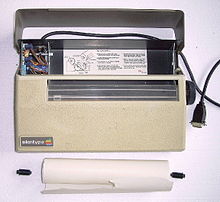
Silentype thermal printer

Apple Magic Mouse (2009)
Search within the encyclopedia